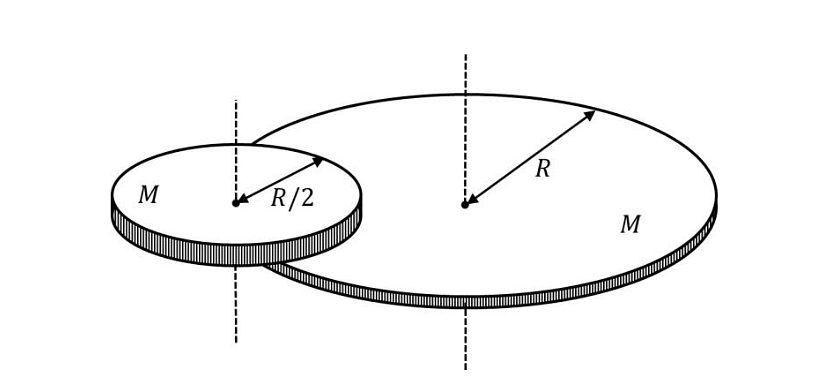A circular disc is rotating about its own axis at uniform angular velocity \(\omega.\) The disc is subjected to uniform angular retardation by which its angular velocity is decreased to \(\frac {\omega}{2}\) during 120 rotations. The number of rotations further made by it before coming to rest is
- 120
- 60
- 40
- 20
The Correct Option is C
Approach Solution - 1
$\alpha = \frac{\omega_1^2 - \omega_2^2}{2 \theta}$
$\frac{\omega - \left( \frac{\omega}{2} \right)^2 }{2 \theta_1} = \frac{\left( \frac{\omega}{2}\right)^2 - 0}{2\theta_2}$
$\theta_2 = \frac{\theta_1}{3}$
Approach Solution -2
\(ω_1^2-ω_2^2= 2αθ\)
\(ω^2-(\frac ω2)^2= 2α \times 120\)
\(\frac {3ω^2}{4}=240α\)
\(\frac {ω^2}{4}=80α\) ………. (1)
No. of rotations further made = n
\(\frac {ω^2}{4}=2αn\)
From eq (1)
\(80α=2αn\)
\(n=40\)
So, the correct option is (C): 40
Top Questions on Uniform Circular Motion
- A particle moving with uniform speed in a circular path maintains :
- NEET (UG) - 2024
- Physics
- Uniform Circular Motion
- A disc of mass \(M\) and radius \(R\) is free to rotate about its vertical axis as shown in the figure. A battery operated motor of negligible mass is fixed to this disc at a point on its circumference. Another disc of the same mass \(M\) and radius \(R/2\) is fixed to the motor’s thin shaft. Initially, both the discs are at rest. The motor is switched on so that the smaller disc rotates at a uniform angular speed \(\omega\). If the angular speed at which the large disc rotates is \(\omega/n\), then the value of \(n\) is _____

- JEE Advanced - 2024
- Physics
- Uniform Circular Motion
- A thin stiff insulated metal wire is bent into a circular loop with its two ends extending tangentially from the same point of the loop. The wire loop has mass 𝑚 and radius 𝑟 and it is in a uniform vertical magnetic field \(B_0\), as shown in the figure. Initially, it hangs vertically downwards, because of acceleration due to gravity 𝑔, on two conducting supports at P and Q. When a current 𝐼 is passed through the loop, the loop turns about the line PQ by an angle 𝜃 given by

- JEE Advanced - 2024
- Physics
- Uniform Circular Motion
- A particle connected with light thread is performing vertical circular motion. Speed at point B (Lowermost point) is sufficient, so that it is able to complete its circular motion. Ignoring air friction, find the ratio of kinetic energy at A to that at B. (A being top-most point)

- JEE Main - 2024
- Physics
- Uniform Circular Motion
- A car is moving with a constant speed of $20\, m / s$ in a circular horizontal track of radius $40\, m$ A bob is suspended from the roof of the car by a massless string The angle made by the string with the vertical will be : (Take $g=10 \, m / s ^2$ )
- JEE Main - 2023
- Physics
- Uniform Circular Motion
Questions Asked in CBSE CLASS XII exam
- Find the inverse of each of the matrices,if it exists \(\begin{bmatrix} 2 & 1 \\ 7 & 4 \end{bmatrix}\)
- For what values of x,\(\begin{bmatrix} 1 & 2 & 1 \end{bmatrix}\)\(\begin{bmatrix} 1 & 2 & 0\\ 2 & 0 & 1 \\1&0&2 \end{bmatrix}\)\(\begin{bmatrix} 0 \\2\\x\end{bmatrix}\)=O?
What is the Planning Process?
- CBSE CLASS XII - 2023
- Planning process steps
- Find the inverse of each of the matrices,if it exists. \(\begin{bmatrix} 2 & 3\\ 5 & 7 \end{bmatrix}\)
- Find the inverse of each of the matrices, if it exists. \(\begin{bmatrix} 1 & 3\\ 2 & 7\end{bmatrix}\)
Notes on Uniform Circular Motion
Concepts Used:
Uniform Circular Motion
A circular motion is defined as the movement of a body that follows a circular route. The motion of a body going at a constant speed along a circular path is known as uniform circular motion. The velocity varies while the speed of the body in uniform circular motion remains constant.
Uniform Circular Motion Examples:
- The motion of electrons around its nucleus.
- The motion of blades of the windmills.
Uniform Circular Motion Formula:
When the radius of the circular path is R, and the magnitude of the velocity of the object is V. Then, the radial acceleration of the object is:
arad = v2/R
Similarly, this radial acceleration is always perpendicular to the velocity direction. Its SI unit is m2s−2.
The radial acceleration can be mathematically written using the period of the motion i.e. T. This period T is the volume of time taken to complete a revolution. Its unit is measurable in seconds.
When angular velocity changes in a unit of time, it is a radial acceleration.
Angular acceleration indicates the time rate of change of angular velocity and is usually denoted by α and is expressed in radians per second. Moreover, the angular acceleration is constant and does not depend on the time variable as it varies linearly with time. Angular Acceleration is also called Rotational Acceleration.
Angular acceleration is a vector quantity, meaning it has magnitude and direction. The direction of angular acceleration is perpendicular to the plane of rotation.
Formula Of Angular Acceleration
The formula of angular acceleration can be given in three different ways.
α = dωdt
Where,
ω → Angular speed
t → Time
α = d2θdt2
Where,
θ → Angle of rotation
t → Time
Average angular acceleration can be calculated by the formula below. This formula comes in handy when angular acceleration is not constant and changes with time.
αavg = ω2 - ω1t2 - t1
Where,
ω1 → Initial angular speed
ω2 → Final angular speed
t1 → Starting time
t2 → Ending time

Also Read: Angular Motion



